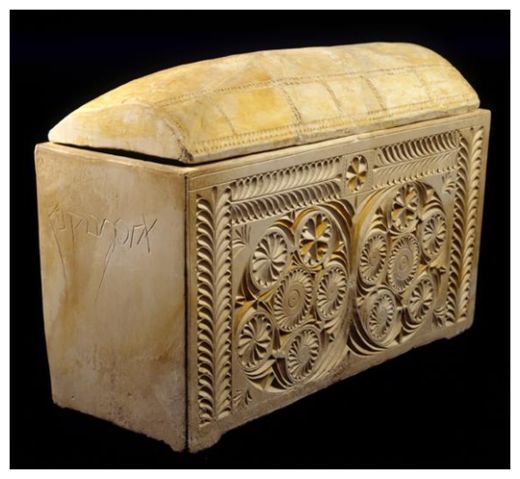
© Israel Antiquities AuthorityCaiaphus Ossuary.
Were the final resting-places of the family and disciples of Jesus discovered 30 years ago and then hidden as part of a religious-political conspiracy?
The archaeological controversy swirling around two Roma-era burial tombs in Jerusalem refuses to die. Indeed, it has become something of an ugly academic slugfest.
In one corner stands the Israeli archaeological establishment represented by the Israel Antiquities Authority and Professor Amos Kloner of Bar-Ilan University, backed by various respected archaeologists and scholars. In the other stands Simcha Jacobovici, the filmmaker and self-styled "Naked Archaeologist," backed by another group of respected archaeologists and scholars.
In 1981, Prof Kloner led
an archaeological survey of a 1st-century burial tomb in East Talpiot, Jerusalem, that was exposed during construction works in the area. Prof Kloner was able to spend only a few minutes inside the tomb before he was chased away by a group of ultra-orthodox Jews who objected to the disturbance of what they suspected were Jewish graves. A number of stone burial boxes or ossuaries were left inside the tomb and it was resealed, eventually hidden under the patio of a newly-built apartment.
The tomb briefly inspected by Kloner was very close to another tomb from the same era that been exposed during construction work a year earlier. That tomb contained 10 ossuaries, of which nine are in the IAA store rooms including ones with inscriptions identifying them as containing the bones of "Yehoshua bar Yoseph", "Miriam", and "Yehuda bar Yeshua (Jesus)".
Jacobovici made a film and wrote a book about each of these burial sites. He dubbed the first one "The Jesus Family Tomb" based on the collection of names that seemed to be members of the family of Jesus. Israeli scholars argued that the collection of names was a coincidence. He also argued that an ossuary inscribed "James, son of Joseph, brother of Jesus" that came to light in 2002 was the missing tenth ossuary - an argument denied both by its owner, who says he bought it before the tomb was discovered, and the archaeologists who said the missing ossuary had no inscription.
Jacobovici dubbed the other "The Resurrection Tomb," arguing that it held the remains of the early disciples and images from early Christian iconography. Crucial to his argument about the second tomb was his discovery of an image inscribed on the side of one of the burial boxes that he said depicted Jonah emerging from a whale.
In the past, Professor Kloner has appeared in Jacobovici's films, but more recently he has denounced the filmmaker. On Thursday, Kloner
laid into Jacobovici at an archaeological conference at Bar-Ilan University, rubbishing his revelations and saying the "fish" was an image of a vase or amphora commonly found in ancient tombs.
Jacobovici tried to ask a question at the conference, but was not allowed to speak. Instead, he has
hit back at Kloner with his own scathing denunciation, accusing the professor of hiding his findings for 30 years and keeping "secret files at home."
Jacobovici is no stranger to controversy. He is currently suing Joe Zias, a former Israel Antiquities Authority official, for libel. Zias has long denounced the discoveries of the Naked Archaeologist, criticism which Jacobovici reveals cost him hundreds of thousands when
National Geographic and the
Discovery Channel canceled broadcasts of his films after Zias challenged their accuracy.
Last year, Jacobovici announced he had found what could be the nails from the crucifixion and accused the Israeli establishment of ignoring their significance. Most scholars said his claims were nonsense.
Jacobovici believes he has discovered the truth about early Christianity and is being targeted from two directions: by the Israeli establishment who want to play down Christian findings in the Jewish state; and by Christians who don't want their religious beliefs undermined by historical evidence to the contrary. He accuses his detractors of being "sleeper agents of Christian theology, masquerading as academics."
But the controversy highlights another problem - the possibility that showbiz is corrupting archaeology. In the old days, scholars could spend years excavating a site, and then more years, perhaps decades, marshaling material and publishing their conclusions.
In recent years, a new hunger for publicity and acclaim has changed all that. As the cost of excavations and scholarship has risen, archaeologists have turned increasingly to private sponsors and commercial organizations to underwrite their expeditions. Publicity has become a key tool for raising money. With the proliferation of cable TV, channels like
National Geographic and
Discovery, closely followed by independent film producers, were able to provide huge injections of cash in return for exclusive access and production rights to the most camera-friendly expeditions. After such heavy investment, the producers expect discoveries that will create headlines and attract large audiences.
Suddenly, every archaeologist is being compared with Indiana Jones, and filmed in what appear to be similar settings.
It is understandable that scholars used to scraping together budgets for research and dusty expeditions might be tempted to participate in productions involving the huge sums revealed by the Jacobovici-Zias libel suit.
"I don't agree with everything they say in the films, but they pay me an awful lot more than I could ever earn from writing or teaching," one archaeologist who has appeared in such productions told me.
Is anyone still interested in the truth no matter where it leads? Gain or permanant prejudice is hurdling us toward another dark age.